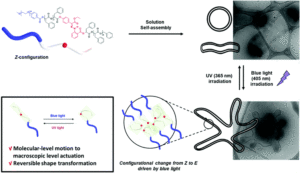Wang et al. synthesized amphiphilic block copolymers bearing photoswitches and evaluated the effect of the photoswitch number and position on solution self-assembly.
Diverse applications of amphiphilic block copolymers (BCPs) stem from their ability to self-assemble into nanostructures with well-defined architectures the shape of which has been shown to bear significant effect on BCP nanostructure properties and applications. In this aspect, photo-triggered polymer vesicles (polymersomes) have been extensively investigated for on-demand cargo delivery as light-triggered conformational changes of the BCPs offer macroscopic actuation of the nanocarriers and enable reversible mass transport through the vesicular membrane without permanent disruption. However, the effect of the number and location of the photoswitches in the BCP on their conformational change has been challenging to study.
To address this, Kim and collaborators synthesized amphiphilic block copolymers composed of hydrophilic polyethylene glycol (PEG) blocks and discrete oligo(phenyllactic acid) (OPLA) blocks containing hydrazone-based photoswitches at specific positions. The photoswitches were selected on the basis of their ability to undergo E–Z isomerization upon light irradiation causing a conformational change on the hydrophobic block. As a result, vesicles formed via cosolvent self-assembly were shown to undergo a reversible shape transformation upon irradiation with UV or visible light. Importantly, the location and number of photoswitches per polymer was shown to have a significant effect. When the hydrazone-based photoswitch was embedded in the middle of the hydrophobic OPLA chains a dramatic membrane deformation was observed causing reversible shape transformation from polymeric vesicles to urchin-like structures. In contrast, when the hydrazone-based photoswitches were embedded at the junction of the hydrophilic and the hydrophobic block, the self-assembled nanocarriers did not undergo shape transformation when irradiating with different light sources. This indicates that the position of the switch in the hydrophobic moiety of the BCP is a decisive factor determining the shape transformation of the nanoparticles driven by the light-induced configurational change of the hydrazone-based photoswitches. It was further shown that when the number of photoswitches embedded in the OPLA chains was increased, the extent of shape transformation was significantly enhanced.
This study offers new insights on the design and development of BCPs for the fabrication of polymersomes tailored for a wide range of potential applications involving on-demand release of cargo molecules.
Citation to the paper: On-demand shape transformation of polymer vesicles via site-specific isomerization of hydrazone photoswitches in monodisperse hydrophobic oligomers, Polym. Chem., 2021,12, 5027-5036.
Link to the paper: https://pubs.rsc.org/en/content/articlelanding/2021/py/d1py00981h
Dr. Kelly Velonia is an Advisory Board Member and a Web Writer for Polymer Chemistry. She joined the Department of Materials Science and Technology in 2007. Research in her group focuses on the synthesis and applications of bioconjugates and biopolymers.












